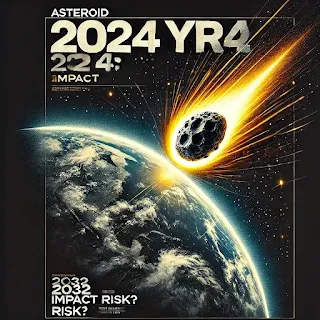NASA and other space agencies are closely monitoring asteroid 2024 YR4, which has raised concerns due to its potential impact on Earth on December 22, 2032. The asteroid, measuring between 130 to 300 feet (40 to 90 meters) in diameter, was first discovered on December 27, 2024, by the Asteroid Terrestrial-impact Last Alert System (ATLAS) in Chile. Initial calculations suggest that 2024 YR4 has a 2.3% probability of impact, which translates to a 1 in 43 chance—a probability higher than usual for newly discovered near-Earth objects (NEOs).
Potential Threat Level
The asteroid has been assigned a Torino Scale rating of 3, which is significant. The Torino Impact Hazard Scale ranges from 0 to 10, where 0 means no risk and 10 indicates a certain collision capable of global catastrophe. A rating of 3 suggests that while an impact is not yet certain, the asteroid deserves attention from astronomers and further observation.
For context, most newly discovered asteroids have a Torino Scale rating of 0 or 1, meaning there is either no chance of impact or an extremely low probability that does not warrant concern. The fact that 2024 YR4 has reached level 3 means that it is being taken seriously, and astronomers are prioritizing tracking its orbit more precisely.
What Would Happen If It Hits Earth?
While 2024 YR4 is not large enough to cause a mass extinction, an impact from an asteroid of this size (130–300 feet) could still have significant local to regional effects. If it were to strike:
1. Local and Regional Damage – An asteroid of this size could create a crater several kilometers wide, destroying anything in its immediate impact zone.
2. Airburst Explosion – If it enters at a shallow angle, it could explode in the atmosphere, similar to the Tunguska event in 1908, which leveled over 800 square miles of Siberian forest.
3. Tsunami Risk – If it impacts an ocean, it could trigger a tsunami, depending on the angle and velocity of impact.
4. Shockwaves and Firestorms – The explosion could release energy equivalent to multiple nuclear bombs, creating a shockwave and heat blast capable of causing widespread fires.
Can It Be Deflected?
If future observations confirm a high probability of impact, NASA and other space agencies could attempt to deflect the asteroid. One potential method is the Kinetic Impactor technique, successfully demonstrated in NASA’s Double Asteroid Redirection Test (DART) mission in 2022.
DART proved that crashing a spacecraft into an asteroid can alter its trajectory. If deployed in time, a similar mission could push 2024 YR4 off its collision course.
Another possibility is the gravity tractor method, where a spacecraft hovers near the asteroid and gradually alters its path using gravitational pull over time.
What Happens Next?
Currently, astronomers worldwide are conducting follow-up observations to refine 2024 YR4’s orbit and reduce uncertainties. Historically, many asteroids that initially seemed like threats have later been ruled out as risks after additional data was collected.
For example, asteroid 99942 Apophis was once considered a major concern for a potential 2029 impact. However, more precise calculations completely ruled out any risk for at least the next century. A similar outcome could occur with 2024 YR4.
Conclusion
Although a 2.3% chance of impact in 2032 is relatively high, the risk assessment is still ongoing. In the coming months and years, astronomers will refine their calculations, and it is highly likely that the probability of impact will decrease as more data becomes available.
However, if the threat remains significant, NASA and global space agencies have proven methods to alter an asteroid’s trajectory and prevent a disaster. In the meantime, scientists are closely watching 2024 YR4, and updates will continue as new observations come in.

